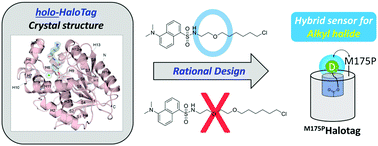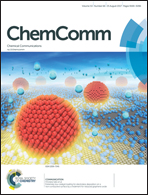Structure-guided synthesis of a protein-based fluorescent sensor for alkyl halides†
Abstract
Alkyl halides are potentially mutagenic carcinogens. However, no efficient fluorescent sensor for alkyl halide detection in human-derived samples has been developed to date. Herein, we report a new protein-based fluorescent sensor for alkyl halides. Analysis of the HaloTag holo-crystal structure with its covalently attached ligand revealed an unexpected cavity, allowing for the design of a new fluorogenic ligand. This ligand showed the highest fluorescence response (300-fold) and fastest binding kinetics (t1/2 < 150 s) to a HaloTag mutant (M175P) protein. This protein-based sensor system was effectively used to detect alkyl halides in human serum and monitor real-time protein alkylation.



 Please wait while we load your content...
Please wait while we load your content...